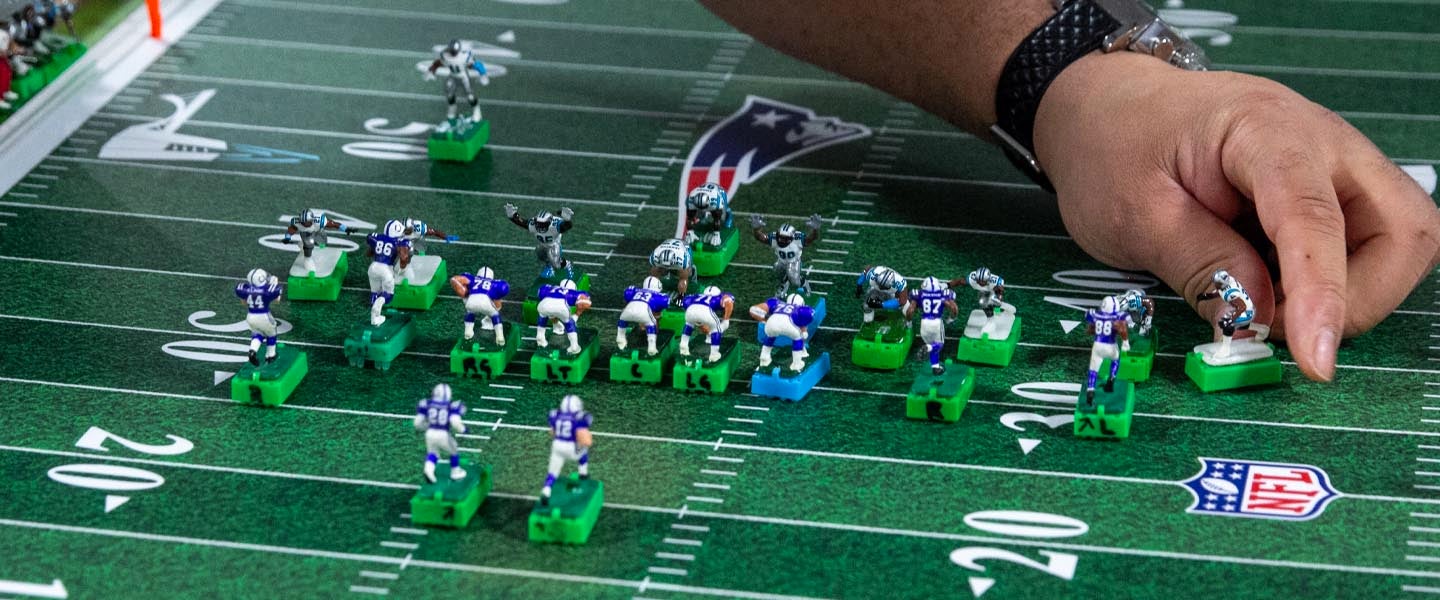Everything stops when we lose the football.
Marcello Troilo is staring at the ground, peering into the dark grain of the hardwood flooring in his kitchen. I’m on all fours, doing the same, quietly wondering why this particular football is so critical to find. “It’s gotta be around here somewhere. It’s a felt football. How far could it have gone?” I offer.
Troilo’s brow furrows as he musters a casual reply. “Yeah, it’s here. I mean, it’s gotta be,” he says, scratching his stubble. “It better be. I’ve had that ball for 20 years.”
A record scratches to a halt in my head. “You’ve had it how long?” I ask in a double-take.
“Two decades. It’s been everywhere with me. Across the country, in all kinds of games and tournaments,” he mutters.
As we crawl around, slowly but surely, I can see the confusion blooming into annoyance and then concern on Troilo’s face. He’s a single dad and district manager of Spearmint Rhino in Southern California, and his quick chuckle and wry sarcasm make him seem pretty unflappable. But as the minutes click by, the energy in the room changes. It’s not just a punched-out piece of felt we’re looking for. It’s practically an artifact — the distillation of two decades of competition and clutch plays. His hand-painted team, an assembly of the greatest New Orleans Saints of all time, watch silently from the dining room table as we poke at dust bunnies and move electrical cords.
Then, at last: “There ya are,” Troilo says, flashing a shrugging, well-you’d-be-nervous-too smile. Pinched between his index finger and thumb is the culprit: A dirty little white ball, designed to be placed on a quarterback figurine’s hand and flicked to a waiting open receiver.
I’m with Troilo, one of the leaders of the California Electric Football League (CAEFL), at his home in sleepy Simi Valley to try my hand at a vintage sport with a very real modern following. It’s easy to see why everyone compares electric football to chess: Each side manipulates 11 “players” on a small-scale metal field, following real-game rules on where people can line up. The players all have plastic bases that can be tweaked, and the trick is that the field is motorized: You turn it on, and the bases begin to move. Most squirt forward, others cut left or right, and some even rattle in place. The diverse figures have different roles, and angles are everything — one bad placement can mean a whiffed block or a blown coverage.
For most of the play, there’s no physical ball on the field: You simply point to either the running back or the quarterback and assign them as the carrier. But if a receiver gets open while your QB is “carrying” the ball, that’s when the critical little felt football comes into play. Troilo has spent hundreds of hours placing that felt onto the arm of his “mechanical” QB, aiming it at a tiny plastic figurine, and hitting it with a flick for a completed pass. Just like his hero Drew Brees is dialed into how a football should feel in his hand, so is Troilo. Basically.
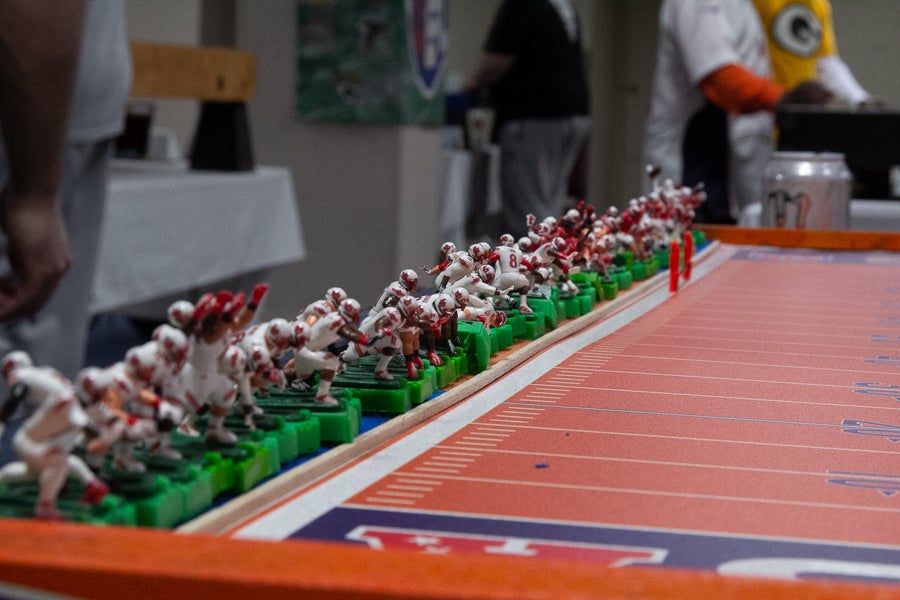
The game was invented in 1948 by Norman Sas, and his company Tudor Games would go onto sell some 40 million units. Most people old enough to remember electric football’s heyday recall it as more chaotic than constructive, with players that appeared to just dogpile into a rattling mess rather than execute anything resembling a football play. But as we resume our scrimmage on Troilo’s smooth-buzzing custom field, he shows off an uncanny ability to know exactly where his players will go. I’m playing with the Colts, a quality team but one I don’t know at all. Over and over, I see his figurines weave around or shut down my guys.
“Anyone who understands and loves football, like you, can get the hang of the strategy,” Troilo says as I watch Marshall Faulk fall over and lose another two yards under the pressure of his defense. “But you only have a couple chances to get your guys lined up right. I move a lineman here, and you forget to block him? That’s a sack. Or you don’t get the right pivot to cover my receiver? That’s an 80-yard touchdown. I’ll know it as soon as I see it.”
This was a revelation to me, a guy raised on shitty Madden games as the only interactive football experience outside of a pickup game. And as I continued to practice against Troilo, I began to understand the obsessive streak I saw in the men who had gathered a week prior at a “community room” in the bowels of a suburban mall in the San Fernando Valley. I wasn’t surprised to open the door and find a half-dozen middle-aged guys. But I didn’t expect to see the sheer amount of gear they brought — namely, steel cases with dozens and dozens of miniature figurines and a rack of four-foot-long playing fields, framed in heavy-duty wood. I thought back to the plastic sack of L.A. Rams players and the tiny, flimsy field I’d bought off Amazon, thinking it would help prepare me. That stuff now appeared the equivalent of bringing a ‘96 Honda Civic to a NASCAR race.
It also became clear that nearly everyone I was going to meet in this hobby had known electric football for a very long time. Some, like Troilo, had picked it back up after losing touch with it once they graduated from high school or college. Some never quit, even becoming pioneering names in the hobby, like Vince Peatros, 57.
Peatros began playing as a six-year-old in 1968, after his eldest brother showed him the game. It was a decade later in high school, however, that he began to discover ways of gaining superior power and speed on the field. He’d taken enough losses at the hands of his best friend Mike, whom he played almost daily. One morning, while staring at his miniature team on the table, Peatros wondered how he could find an edge. He ran his fingers over the thin prongs on the bottom of his player’s bases, tugging at the lime-green plastic. They stretch, he realized. A whirr of the field proved that a little change could have big effects — his linemen now vibrated across the turf faster than the four others he hadn’t touched.
“I worked on those things for seven or eight hours that day. The next day, we get to school and the first thing Mike asks me is, ‘We gonna play today?’ I told him, ‘We sure are.’ I was ready,” he tells me with a short laugh. “He came over to my house, and I beat him 56 to nothing. He had this look on his face. The whoopin’ boy is whoopin’ me. I was hooked.”
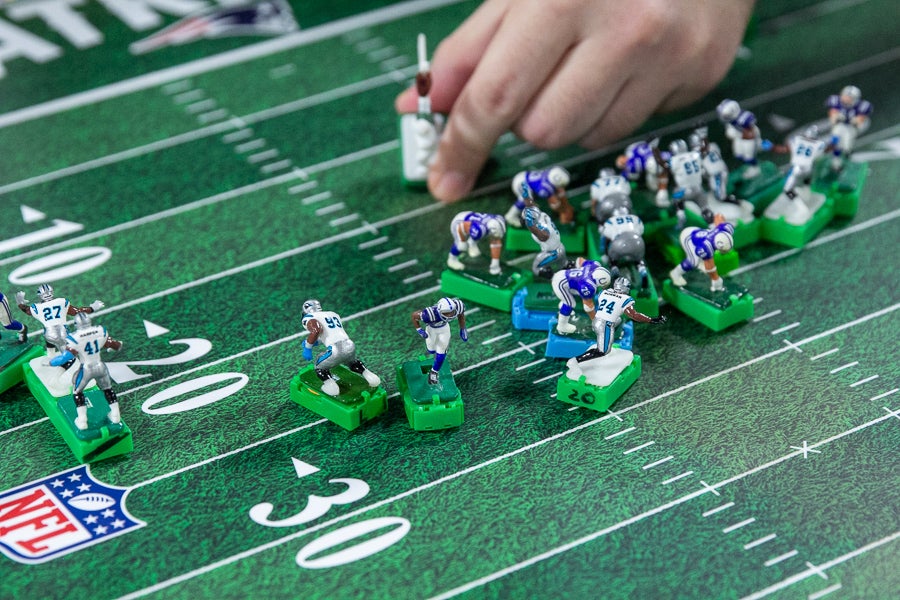
Another innovation would come in 1996, when Peatros found that boiling the bases in water and baby oil could help the plastic soften and stretch all over, making for smooth, fast player movement. As one of the best base tweakers in the world, Peatros’ influence extends across countless players in the national electric football scene, including Troilo, who uses his bases. When he receives a new box of the green parts, he’ll tweak for as long as 12 hours straight, testing the batch in the cool quiet of his garage.
Electric football has stopped being just a game for many of the men around the country who have signed up for the CAEFL’s Super Bowl-adjacent tournament, dubbed “Fault Line Rumble.” The sheer amount of time they’ve spent around each other means there are reputations to uphold, for one. Grown men can turn into “little bitty boys” and throw tantrums over a big game, Troilo says. “It’s kind of like Days of Our Lives, but with a bunch of graying football guys,” he tells me with a wink.
Still, the jabs and trash talk also come with a physical and emotional camaraderie that’s hard to replace with video games or even watching actual football. Everyone I meet says part of the joy is that electric football is such a niche sport. It’s why Tim Riley, who plays in the CAEFL with his son, Matt, gets a little emotional when he shows me a tiny figurine of a Chiefs player. His back reads “MO RILEY” — Tim’s father, embodied as part of the family’s favorite team. “Cello and Matt and a couple of the guys used a photo of my dad to make this custom and make the name decal and everything,” he says in a hoarse rumble. “That’s pretty cool, huh?”
And those bonds extend beyond individual leagues, thanks especially to the internet. Peatros observes that tournaments like Fault Line Rumble continue to bring the same faces together, regardless of home lives, jobs or the cost of travel. Many of the men look forward to the tournaments all year long, he says. “It’s the only place where a bunch of 50-, 55- and 60-year-old men can migrate to play a game and act like we’re 14 again. But more importantly, while we’re there, we’d never even think about our own personal problems that we all face on a day-to-day basis,” he concludes. “So for me, it’s therapy.”
Well, a competitive form of therapy, anyway. And somehow, I end up not just as an observer, but an active competitor in the tournament thanks to Troilo’s urging. Scrimmaging with him at home is literally the first time I’ve gotten to play the game. But apparently, my newfound mentor has seen enough football knowledge and intuition to throw me in the deep end. The hobby needs fresh blood — and I’m pretty good at passing the ball.
As I’m about to leave, he hands me a tiny plastic container with a throwing QB figurine, a couple of normal players and a little felt ball of my own. The instruction is simple: Practice throwing that ball for 15 minutes a day, all week, while imagining my offensive formation.
“Oh, and don’t lose that ball,” he says with a grin. I imagine myself on all fours looking for a brown felt ball in my beige carpet, and laugh out loud.
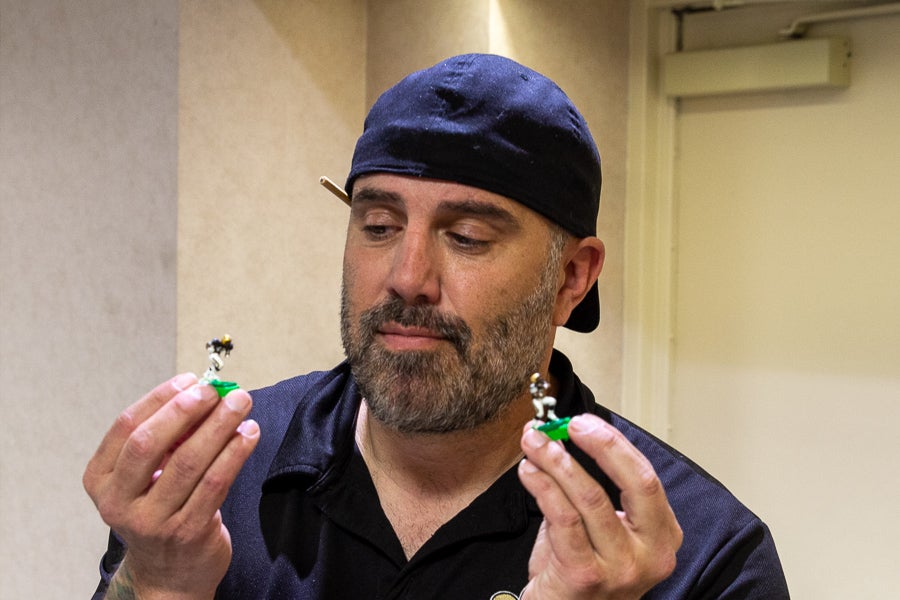
* * * * *
I didn’t think I’d start sweating at 8:30 in the morning in an airport hotel conference room, but I also didn’t expect Marshall Faulk to get open out of the backfield.
Amid a clutter of plastic Colts and Chiefs bodies entangled into a stalemate, there Faulk is, untouched by a defender, with 50 yards of open steel ahead of him. I point to him, and Tim Riley begins a 20-second countdown. My fingers feel fat and clumsy as I place the felt ball on the tip of my throwing QB’s hand. Carefully, without knocking over any figurines, I pull my tiny Andrew Luck off the field and slip in my throwing figure, aligning the arm with Faulk, about five inches away. It might as well be five yards. My right index finger is quivering.
“Take your time,” Riley whispers. “Line it up. Twelve. Eleven. Ten. Nine…”
I close an eye to aim and remember Troilo’s words: “Angle it forward more than you think. Throw it firm.”
“Six, five….”
My index finger pulls back the spring-loaded arm. The brown felt flies into Faulk’s ass, and I exhale hard. “Hit! Defense has the switch.”
Riley is pleased for me, but not thrilled about the outcome. This is still the qualifying stage of the tournament, where point differential matters on top of wins and losses. I saw him in the same room last night, fiddling the base prongs by himself with a pair of pliers and a small lighter. “Tyreek isn’t running right,” he told me, pointing annoyedly at a tiny Chief with the number 10. And he isn’t doing much against me in this game, either — Riley is only up 7-0 in the second half, thanks to a series of uncharacteristic missed passes.
Now, seeing Faulk with room to run, he moves fast. Riley picks up three untouched defenders, pivoting them toward the Colt so they can “chase” the ball and hopefully prevent the score. With that complete, his left hand drops to the switch. Buzzzzzzzzzzzzz — Faulk is rocketing toward the end zone, and no one’s catching him. I start to bounce in place, holding in a yell that bursts out anyway as he crosses the line. Touchdown. “Awww, shiiiit,” Riley groans, rolling his eyes
with a grin.
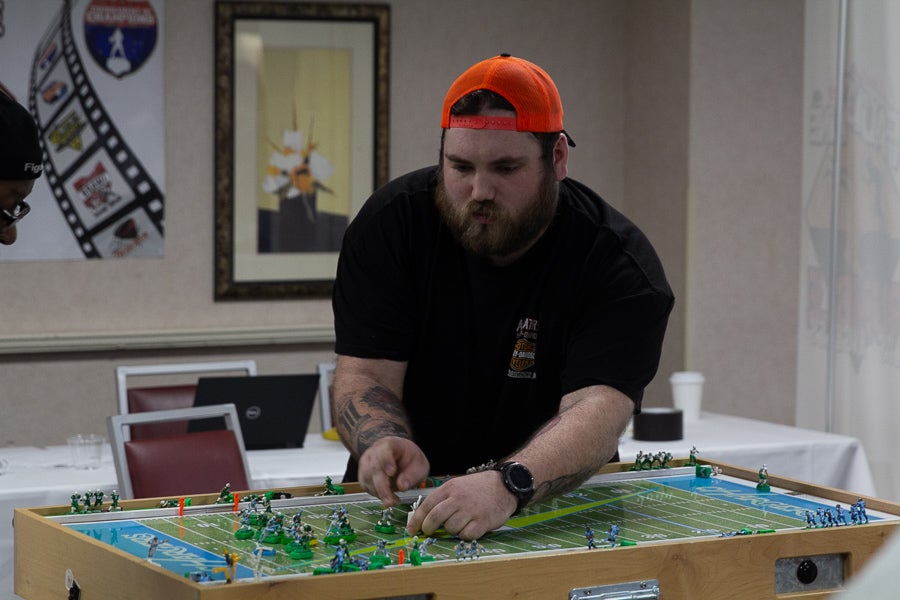
For a second, I’m high on the vapors of my first score, imagining myself making a Cinderella run into the tournament. This has been a big morning of firsts: First pass completion, first touchdown, first fourth-down stand on defense. And to my shock, 15 minutes later, we’re still tied up. I’m sitting on his 35-yard line, with the game clock ticking down the last 25 seconds. Riley is sweating bullets, pondering the absurdity of losing to a total newbie as I prep a game-winning field goal.
The kicker, like my spring-loaded throwing figurine, is a piece of custom kit I borrowed from Troilo. The ball at his foot is a special tiny leather ball designed by a friend of his for max accuracy and distance. It should be a layup. But fortune is done smiling on me for the rest of this game. I’m nervous, and as soon as I pull the kicker’s spring-loaded trigger, I know it’s off. Wide left.
Riley beats me on the next play, in overtime. This feels needlessly cruel, even for an Andrew Luck-led Colts team. I’m elated, and heartbroken, and in disbelief at how quickly 50 minutes of real game time can fly by so quickly. Over the next two qualifying games, however, I only score one more touchdown. I’m disappointed until I tell Troilo that I caught J.C. Davis, a soft-spoken member of the Bay Area Electric Football League who’s been helping me all day, with a Luck scramble right through the middle of his defense for a 65-yard touchdown.
“He doesn’t act like it, but that guy’s a legend in his own right. He puts up massive points against unprepared people. You kept him to three touchdowns and scored one of your own?” Troilo says, grabbing my shoulder. “You’re doing great.”
Given that we’re all playing with little plastic toys, it’s almost easy to forget that I’m standing among some of the best in the game, ever. At least until they start beating the brakes off me, or when their players just dominate my guys without reprisal. Davis is a master of both his offensive philosophy and the literal shape of the players he places on the board, given that his side business is selling custom-molded figures. They’re coveted by seemingly everyone in the room, and included in a lot of teams I examine. “It’s not just a look or preference. Things like extended hands hook opposing figures. You can get linemen who are trying to bat the ball down. It can make collisions happen differently,” he tells me as we play. “It’s almost the game within the game.”
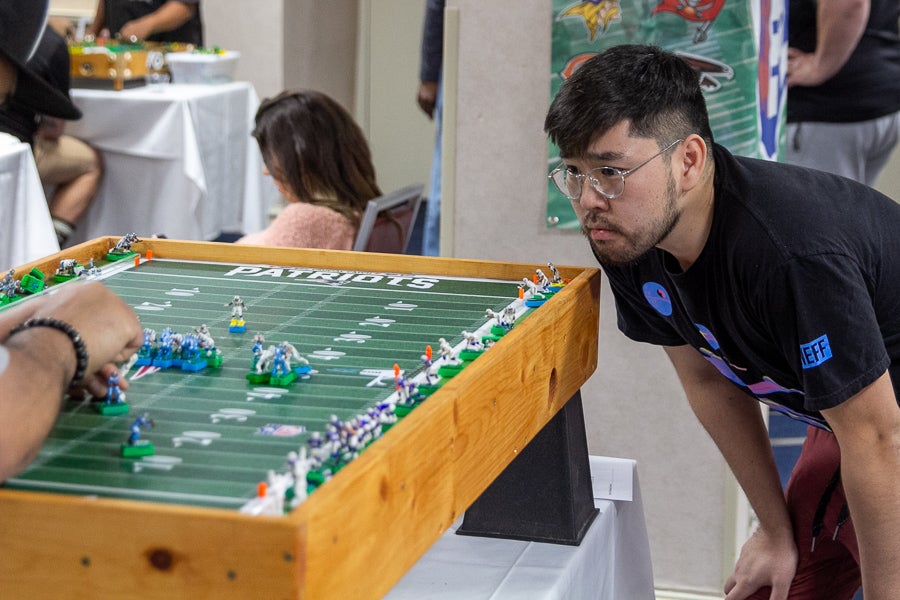
I don’t qualify for the single-elimination tournament bracket, but it’s alright — after three hours, I’m surprised by the exhaustion setting in, both mentally and on my back. Peatros is the No. 1 seed, with a staggering +75 point differential after three qualifying rounds, and he spends his “bye game” resting drowsily in a quiet corner. All around us is the chorus of high-pitched whirrs, with timbres as diverse as the men around them. The men who get eliminated still play with their figures, scraping putty, weighing them on gram scales and letting them run drills on the field. IPhones slip out of pockets to capture intriguing offenses and shutdown D. Dallas stalwart Pat Morris and reigning Fault Line Rumble champion Marty Thomas (of Las Vegas) both tell me that they literally review tape in order to improve.
“You have to have a passion for it, for sure. Because you really will get overwhelmed and get frustrated and that could take a toll on you. Especially if you’re really not winning. Every day of my life, I take serious. Because tomorrow ain’t promised. I put all into my job as a crane operator, and I put all into this, too,” Thomas says, eyes sparkling with energy. “I’ve been in it for so long, so this is a competition, now. This ain’t relaxing to me. This is blood, sweat and tears. That’s the way I look at it. I ain’t here to play. I ain’t here to giggle. I’m here to win.”
Even from the first round of tournament games, it’s obvious that stakes are high. I can’t help but watch with rapt attention as Troilo throws body blows in a tight game against Doug Shanafelt, with the bickering rising as the clock winds down. (A typical exchange: “Hurry up and move your guys.” “No, get your guys.” “I’m trying!” “Well so am I.” “Then get your hand on your side!”) Up 21-20, with a minute on the clock, Troilo watches with tight-lipped dread as Shanafelt slides into the end zone.
There’s a pause in the air. Then, finally, breaking the seal for the day: “FUUUUUCKKKKKKK!”
“Excuse my language,” Troilo adds quietly. No one else says a thing — the moment’s too sensitive.
And yet for all the competitive tension, all the outbursts, all the fighting over penalties — and more bickering after the fact over people claiming that reffing stole their games — what I mostly remember from tournament day is the sound of belly laughs hanging in the air. I see Thomas, who told me he wasn’t here for giggles, doing just that while trading stories at the hotel bar. I overhear people trading ideas, and bases, and collaborating in the aftermath of defeat. A group huddles outside, sharing a blunt, cracking wise. At one point, 25-year-old JaRon Turner sidles up to me, eyeballing my paper cup of coffee.
“What’s in there? Unmarked cups usually mean a little extra fun,” he says, tipping a shot of brandy into it.
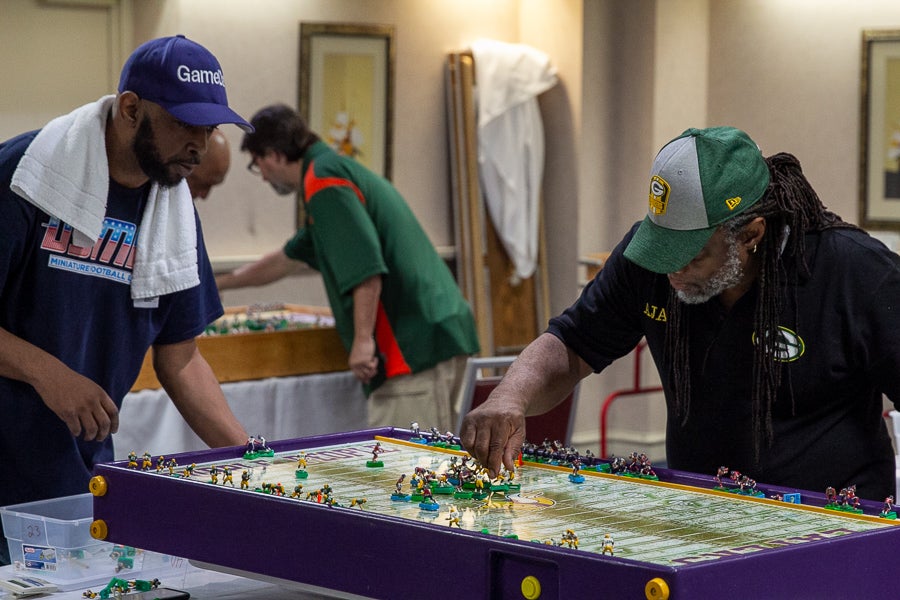
JaRon and his father Mike Turner are one of a number of father-son duos I met or heard about at the tournament, and it’s the bond that most consistently brings new players into the electric football world. Dakota Fricke, a member of the Kansas City league, was dragged into it by his father and ended up fascinated. Davis, the offensive guru with the figure business, plays in Bay Area tournaments with his 12-year-old son (“I’d take him traveling, but right now, I’d have to chaperone and, uh, it’s selfish but I want this for me!”). And while there were no women participating in the tournament, it’s possible Troilo’s 11-year-old daughter could break the glass ceiling — well, in L.A., anyway.
But the bond can come with its own expectations, and JaRon Turner sighs as he mulls the losses he took earlier that day. “I like that Pops plays for the love of it now, to be honest. Talking shit, drinkin’ a beer. That’s good. But I’m a college student. I’m not rich. And those guys in there, they treat things like a real NFL franchise — except there’s no cap. If you’re an ear surgeon in Texas, you can buy 1,000 bases like no big deal. You can pay and get those bases dialed in perfect by someone else. I can’t, and I’m trying to find a team that’ll do something for me.”
* * * * *
The championship game on Sunday goes as the seeding does: No. 1 Peatros, with a commanding point differential through the tournament, shuts down Kelley Newton’s passing attack for a wire-to-wire 21-7 win. It’s a huge victory for the CAEFL, and a win for California in general, since it brings home the trophy. The aftermath is a slow process; nobody really seems to want to pack up all those cases and fade back into the real world. But checkout beckons, as do flights. There are final toasts and lingering hugs.
Despite the finality of the weekend, a new season will begin soon, with games to play in the spring and summer months. Troilo jokes that my promising performance has made me the envy of the tournament — a flattering half-joke that makes me want to keep going. In the eyes of the men who have been playing for decades, new recruits are walking lifelines for the hobby. Peatros has little optimism about what will happen in the sport if it doesn’t get some splashy attention, as with an HBO reality show on competitive electric football that he tried to make happen about a decade ago. “If we don’t do something like that, the sport will die with us old-timers,” he says, matter-of-factly.
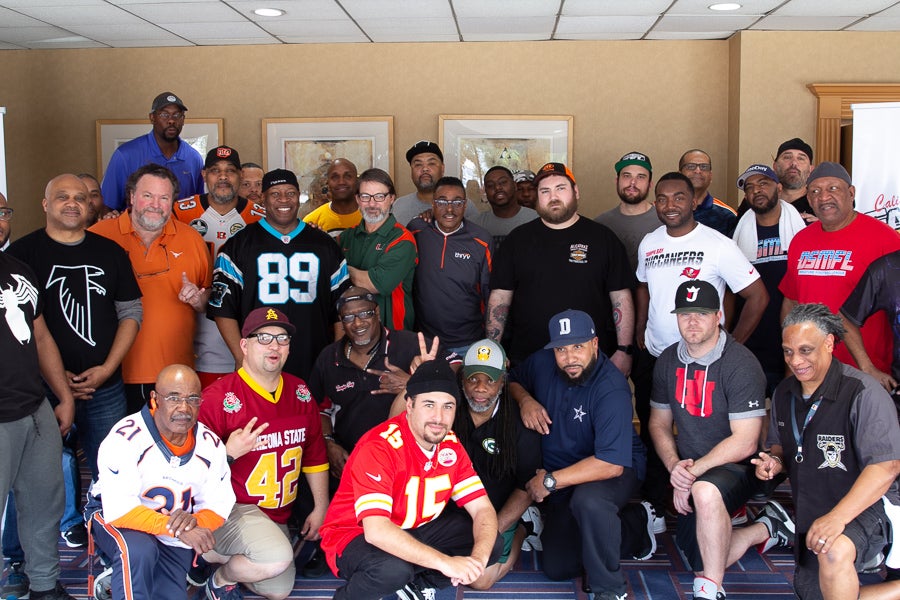
The first taste of success is addictive, but will I keep going if I keep losing, like JaRon Turner expressed? Maybe, and it’s obvious that for a lot of the men I met, the fight for dominance is the allure. But I think of the dissent from Mike Beal, a former law enforcement officer who plays electric football with the Bay Area league. Beal is famed for his pioneering decals, which offer a level of precise decoration that hand-painting can’t quite match. It’s not just names, numbers and helmet logos — he sells kits with stripes, shoe laces and even glove art. Over the last four decades, it’s not winning on the buzzing field that’s kept him involved, so much as finding a niche within the niche.
“Kids maybe have some action figures here or there, but the next thing you know these days, you’re into video games. This is so different — a three-dimensional object you can touch and create. I mean, the sky’s the limit on your creativity, and with 3D printers now, things are only going to get better and better,” Beal tells me. “I really see a potential for this sport, if it’s handled correctly, to really make a renaissance, as crazy as that sounds.”
I’ll be sticking around, for now, because it feels like I’ve discovered a whole new ocean to explore. Electric football coalesces so much of what I love about the real sport of football — the fandom, the tactical expertise, the energy — but with a lot less CTE-related guilt to mull on Monday (for me, anyway). And I smile when I think about Troilo’s final gift to me: He wants me to keep the Colts set, and a buzzing Colts field, until I need to move or want to quit. While the gear belongs to a former leaguemate on hiatus, the offer alone surprised me — like a torch being passed to me from the guy who is, for all intents and purposes, my electric football mentor. “It’s in the spirit of the game,” he says, and I flash back to the deeply supportive attitudes I encountered all weekend from strangers.
I’ll have to wait a little bit, though. Troilo thinks my squad needs a little more work, which he’ll tackle with some pliers and a lighter. I might be learning quick, but there’s a couple decades to go.
